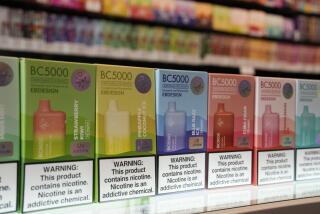U.S. to Pursue Lawsuit to Curb Cigarette Marketing
- Share via
The Justice Department is demanding sweeping changes in tobacco marketing and manufacturing practices as part of a federal lawsuit that many observers had expected to be dumped by the Bush administration.
In a document turned over to industry lawyers, Justice Department attorneys said they would seek a court order forcing tobacco companies to reduce levels of nicotine, the habit-forming substance in their cigarette brands, “to the greatest extent possible.”
They called for a slew of other anti-smoking measures, including elimination of cigarette advertising in stores, use of graphic warning labels filling at least 50% of the space on cigarette packs and print ads, and a ban on lobbying against ordinances directed at secondhand smoke.
The multibillion-dollar suit is a holdover from the Clinton years, and many thought the Bush administration--buoyed by millions of dollars in tobacco contributions to the Republican Party--would abandon or settle it on terms favorable to the industry. Such expectations mounted last year when Atty. Gen. John Ashcroft initially sought only $1.8million to fund the litigation team.
Yet certain of the curbs surpass even the optimistic wish lists of public health advocates. The measures are spelled out in a 47-page document given to the industry in December to indicate what the government hoped to gain from the litigation.
Tobacco companies agreed in 1998 to marketing restrictions as part of their $246-billion settlements with the states. But the Justice Department proposals are tougher than those included in the state settlements.
“It wouldn’t be surprising at all for the Reno Justice Department to ask for this,” said an industry spokesman who would not speak for attribution, referring to former Atty. Gen. Janet Reno. But for the demands to surface under Ashcroft “is remarkable,” he said.
It suggests either that Justice Department attorneys involved in the case are “completely off on their own” or that Ashcroft “has taken up the banner and decided this industry really does need to be dealt with severely,” he said.
Defendants include Philip Morris Cos., R.J. Reynolds Tobacco Co. and Brown & Williamson Tobacco Corp.
Seth Moskowitz, a spokesman for Reynolds, said the company was continuing to prepare its defense of the case, which has a trial date of June 2003. “We don’t believe there is a need for additional advertising and marketing restrictions that go beyond those detailed in” the states’ settlements, he said.
Reactions from industry foes ranged from cautious optimism to enthusiastic praise.
“This is an amazing change of heart by the administration, which has been lukewarm to cold about this litigation,” said Sen. Richard Durbin (D-Ill.), a leading tobacco critic in Congress.
“I worry that maybe this reflects the career people at Justice and not the full commitment of the Justice Department leadership,” said Rep. Henry A. Waxman (D-Los Angeles), “but I’m waiting to be pleasantly surprised.”
Justice Department spokeswoman Susan Dryden said Monday that the department has made a commitment “to this litigation, and this document reinforces that.”
Filed in September 1999, during President Clinton’s second term, the suit originally sought recovery of billions of dollars a year in smoking-related health-care costs paid by U.S. taxpayers. U.S. District Judge Gladys Kessler dismissed the cost recovery portion of the suit but has allowed the government to pursue claims that tobacco companies were guilty of fraud and racketeering in concealing the hazards and addictiveness of smoking.
According to the Justice Department document, court- appointed officials would monitor the industry’s compliance. Among the demands:
* An end to the estimated $3.54billion the industry spends each year on point-of-purchase advertising and promotions, including in-store signage and display racks.
* Restriction of cigarette ads to black-and-white print format. Alluring imagery, such as people driving fast cars or cavorting at the beach, would be barred. And warning labels would have to cover at least 50% of advertising and package space.
* Creation of a foundation to develop, test and promote less hazardous cigarettes, funded by cigarette makers.
* Stiff penalties to tobacco companies if underage smoking fails to decline by target amounts. The targets include a 60% reduction in 10 years, with the companies liable for at least $80million for each percentage point short of the goal.
As part of their settlements with the states, tobacco firms agreed to eliminate billboards and transit and stadium signs. They also pledged not to use cartoon characters in promotions and to bar distribution of caps and shirts with tobacco logos.
*+
Times staff writer Josh Meyer in Washington contributed to this report.
More to Read
Sign up for Essential California
The most important California stories and recommendations in your inbox every morning.
You may occasionally receive promotional content from the Los Angeles Times.










